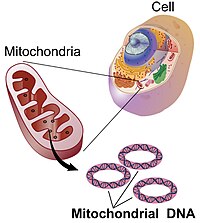
Photo from wikipedia
The Escherichia coli protein toxin cytotoxic necrotizing factor 1 (CNF1), which acts on the Rho GTPases that are key regulators of the actin cytoskeleton, is emerging as a potential therapeutic… Click to show full abstract
The Escherichia coli protein toxin cytotoxic necrotizing factor 1 (CNF1), which acts on the Rho GTPases that are key regulators of the actin cytoskeleton, is emerging as a potential therapeutic tool against certain neurological diseases characterized by cellular energy homeostasis impairment. In this brief communication, we show explorative results on the toxin’s effect on fibroblasts derived from a patient affected by myoclonic epilepsy with ragged-red fibers (MERRF) that carries a mutation in the m.8344A>G gene of mitochondrial DNA. We found that, in the patient’s cells, besides rescuing the wild-type-like mitochondrial morphology, CNF1 administration is able to trigger a significant increase in cellular content of ATP and of the mitochondrial outer membrane marker Tom20. These results were accompanied by a profound F-actin reorganization in MERRF fibroblasts, which is a typical CNF1-induced effect on cell cytoskeleton. These results point at a possible role of the actin organization in preventing or limiting the cell damage due to mitochondrial impairment and at CNF1 treatment as a possible novel strategy against mitochondrial diseases still without cure.
Journal Title: International Journal of Molecular Sciences
Year Published: 2018
Link to full text (if available)
Share on Social Media: Sign Up to like & get
recommendations!